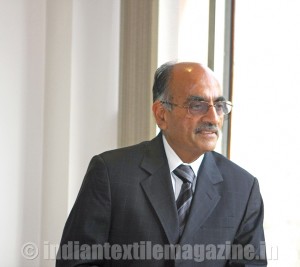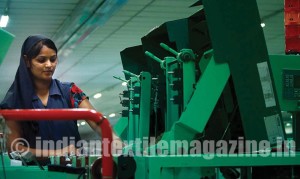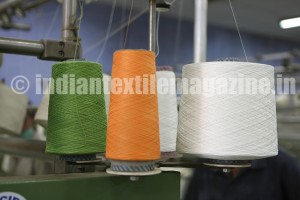Vardhman Textiles Ltd. (VTL), the largest listed, integrated textile manufacturing company in India, is a dominant player in areas like yarn, fabric and sewing threads. With its strong position in acrylic staple fibre and wide presence in garments, it has 25 manufacturing facilities employing over 26,000 persons.

Vardhman enjoys market leadership in key product offerings. The largest yarn manufacturer in India with a capacity of one million spindles, including 7,188 rotors, Vardhman is the leading manufacturer and exporter of cotton yarn and piece dyed fabric. It is also the second largest producer of sewing threads and a market leader in hand-knitting yarn in India. VTL has forged global alliances with leading textile companies such as American & Efird (A&E) and Marubeni and Nisshinbo, both of Japan.
Yarn & fabrics
Vardhman has also forged technical tie-ups with well-recognized global corporates of Japan and Korea to strengthen the business. One-third of its total yarn production is exported, one-third is sold in the domestic market and balance is utilised for captive looms. The company has been focusing on automation and customer base expansion. It has de-risked business through value-added and specialized products. During 2015-16, it has invested Rs. 180 crores largely for modernisation, debottlenecking and line balancing. The company has planned capex of Rs. 200 crores for FY17.
VTL’s weaving and processing capacities continue to expand in tandem and stand at 170 million / 110 million meters of fabric per annum. One of the few fully integrated fabric suppliers in the country and the largest producer of stretched fabric, the company produces a variety of fabrics for tops & bottoms for men, women and children.
VTL also specializes in finishes like liquid ammonia, teflon / nanocare (oil & water repellent), ETI, etc.
The brands accounting for 40 per cent of sales include GAP, H&M, Uniqlo, S’Oliver, Benetton, Van Heusen, Peter England, Wills, etc. Sales are distributed evenly across the globe, with 40 per cent to Asia (including India), 33 per cent to the US and 27 per cent to Europe. VTL invested Rs. 175 crores for fabrics business in FY16 and plans capex of Rs. 350 crores for the current financial year.
Sewing thread business
Vardhman remains the second largest brand of specialized threads in India. In a strategic decision VTL has agreed to sell 40 per cent stake to the joint venture partner American & Efird, Inc. USA (A&E). This is a win-win situation for both parties as A&E consolidates the threads business on its books and VTL focusses on growing its core businesses of yarn and fabric. The partnership continues as VTL retains its 11 per cent stake for a minimum period of three years. The strategic alliance as a licensee for manufacturing & distribution of A&E branded sewing threads in India continues.
The business of sewing threads is a bit complex and requires significant management time and attention. In case the group chose to retain and grown the thread business, yarn and fabric growth might be hit. Therefore, VTL has taken a pragmatic and long-term view of disinvesting in favor of A&E and concentrating on strengthening the core yarn and fabric business.
VTL’s garment business which started as a forward integration strategy in a 51% JV with Nisshinbo Textiles Inc. for production of shirts (both for sale in India and export to the US, Europe and Japan) is now profitable and continues to show improvement in performance.
Yarn vs. fabric
Spinning has low entry barriers, but a large portion of the global capacity is old and inefficient, thereby leading to low utilization. Given that there is over-capacity at the global level, return on capital investment in a new spinning unit is low. However, returns tend to move up as annual capacity addition is made at a progressively higher cost, thereby enabling older entrants to have a better conversion margin.
Fabric per se has much greater entry barriers than yarns, as the minimum capacity required to be competitive in the longer term entails an upfront and additional infusion to fund initial losses before the business can be stabilized and high utilization established.
India is almost similar to China when it comes to competitiveness in spinning, and efficient players like VTL have in fact made considerable exports to China. China’s advantage with fabric has been reducing as labor costs rise, and integrated players like VTL are able to compete effectively in the global market. This trend is expected to continue.
Bangladesh and Vietnam have clear advantages over other countries, including India, when it comes to garments, and this is expected to continue till substantial labor reforms are put in place in India
Future plans
VTL will stick to its core competencies of textile manufacturing. Why not garmenting? VTL feels that garmenting is a business with very different skill sets, risks and rewards, and although it has undergone a learning curve towards building a profitable garments business, the company believes that the current policy framework doesn’t favour large-scale garment manufacturers. It is, however, not averse to taking a relook if and when the business environment for garmenting in India improves.
Why not branding / retailing? VTL does not believe that branding/retailing is the logical extension to manufacturing. It is also sure that branding and apparel retailing are businesses with very different skillsets, risks and rewards and therefore is not planning to pursue them at least in the near term.
Within textile manufacturing, VTL’s vision is to become a one-stop shop for its large clients for their yarn and fabric requirements. The company is planning to foray into printed fabrics, which considered a step in the right direction. Printed fabrics was a gap in the VTL’s product offering which is in the process of being plugged, as capacity is being created for the same in a phased manner. It commissioned the first phase of its printed line in March, and it is currently being stabilized, a process that may take 3-6 months.
VTL will look for more strategic additions to the product portfolio. Besides cotton yarn and blends, it may look at more synthetic and blended yarns and addition to the existing fabric processing capabilities in the future, including expansion in stretch fabric, etc. The company has committed capex of Rs. 750-800 crores in the next two years.

